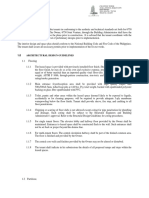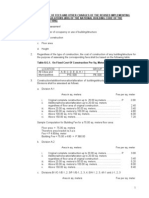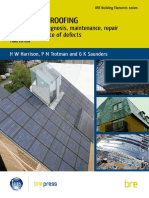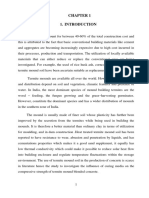10.00 Internal Walls and Partitions v19
10.00 Internal Walls and Partitions v19
Uploaded by
Joseph Cloyd LamberteCopyright:
Available Formats
10.00 Internal Walls and Partitions v19
10.00 Internal Walls and Partitions v19
Uploaded by
Joseph Cloyd LamberteOriginal Description:
Copyright
Available Formats
Share this document
Did you find this document useful?
Is this content inappropriate?
Copyright:
Available Formats
10.00 Internal Walls and Partitions v19
10.00 Internal Walls and Partitions v19
Uploaded by
Joseph Cloyd LamberteCopyright:
Available Formats
Design Guidelines & Procedures Version 19 ©
10.00 Internal Walls & Partitions
10.01 Generally
Building interiors shall be designed to provide maximum flexibility for future modifications or
change in use.
Load bearing walls shall be minimised and restricted to areas such as the building core for
stairwells, lift shafts and toilets. All other internal walls and partitions shall be non-load bearing
and able to be readily removed and altered at minimum cost.
10.02 Masonry Walls
Load bearing walls shall be concrete or concrete masonry as determined by application and
economy.
Non load bearing masonry walls shall be restricted to plant rooms, service ducts and the like, or
where required to achieve fire ratings or acoustic requirements not achievable by other wall
systems.
Any exposed concrete walls shall have a minimum Class 2 ‘off-form’ finish.
All face blockwork shall have half round radius ironed joints.
Adequate control and expansion joints shall be provided to prevent cracking due to building
structure settlement. If the concrete is untreated, then colour control of the concrete shall apply
as previously outlined in Section 8.00 Clause 8.03.
10.03 Framed Partitions & Linings
Internal partitions shall be constructed using not less than 76 x 0.55mm BMT steel stud and track
framing components. Size and thickness of framing components will be dictated by height and
load imposed by wall mounted fittings and equipment.
All framing shall generally extend to underside of slab over, and adequate nogging shall be
provided for the installation of wall mounted fittings and equipment. Deflection head tracks shall
be used to accommodate slab deflection.
Framed partitions shall be sheeted with recessed edge plasterboard with flush set joints. The
thickness and number of layers of plasterboard sheeting shall be to suit the application or to
satisfy acoustic and fire separation requirements, but sheets shall not be less than 13mm thick.
For spaces where the SDF nominates a significant number of fittings or equipment items
mounted on or supported by the partition, consideration should be given to substituting individual
framing noggings with a structural plywood lining to the full extent of the partition/s faced with
10mm thick plasterboard.
Fibre cement sheet linings shall be used in wet and heavy use areas, and shall not be less than
6mm thick.
The lining shall extend from floor level to underside of slab above on at least one side of the
partition between functional spaces and corridors, foyers and other public spaces for security,
and between all spaces to achieve acoustic separation. Linings need only extend full height both
sides if required to satisfy acoustic or other criteria.
Where the top floor of the building is covered by a steel framed roof, partition linings need not
extend to underside of roof except for acoustic or fire separation reasons, but shall extend at
least 300mm above ceiling level on both sides.
All partitions between Chemistry/Biochemistry laboratories and corridors, foyers, toilets and the
like shall be lined full height both sides well screw fixed for maximum security, also stud framing
Internal Walls & Partitions Section 10.00 / Page 1
Design Guidelines & Procedures Version 19 ©
and linings shall extend to the underside of roof framing if located on the top floor level unless an
alternative security barrier is approved by the Deputy Director (PD&C) CLF.
All penetrations in partition linings shall be sealed to maintain the required acoustic rating of the
partition.
In the interests of future flexibility, consideration shall be given to using partitions which extend
only from floor level to the underside of the suspended ceiling. If this approach is adopted,
particular attention must be given to limiting the transmission of noise between spaces such as
the use of seals between the partition capping and the ceiling tiles, insulation batts laid on top of
the ceiling tiles over the top of the partition, or the use of baffles in the ceiling spaces. Given the
requirement for greater use of single glass in corridor walls for the penetration of natural light,
and doors which are not fully acoustically sealed and are often left open, the acoustic integrity of
spaces is compromised and therefore the acoustic requirements outlined in Section 2.00 Clause
2.28 are not achievable.
It is also important that these partitions are stabilised to prevent distortion resulting from the
weight of wall mounted fixtures and fittings. This may be achieved through extending a proportion
of the framing studs to the underside of the slab or roof framing over or other top plate bracing
methods. These extended studs or bracing shall not be attached to any ductwork or cable trays.
The use of ceiling height partitions shall be assessed on a case by case basis with CLF, but shall
not apply to spaces where a high level of privacy or security is required e.g. interview, consulting
and meeting rooms, and laboratories.
10.04 Linings to Masonry Walls
Plasterboard linings to masonry walls shall generally be adhesive fixed in accordance with the
manufactures printed instructions.
If the wall to receive the plasterboard lining requires power points, data outlets and the like, then
the plasterboard should be fixed on metal furring channels. Chasing of masonry walls for cabling
etc. is not acceptable.
All fibre cement linings to masonry walls shall be fixed on metal furring channels.
Fibre cement linings to receive ceramic wall tiling shall be fixed strictly in accordance with the
manufacturer’s printed instructions. Sheets shall be installed to allow expansion joints to be full
depth of tiles and lining.
10.05 Wall Protection
Anodized aluminium angle protection shall be provided to external corners of all partitions. The
angle shall be 38 x 38mm, adhesive fixed and filled and continuous from top of floor coverings to
underside of ceiling. Exposed ends to all nib walls shall have full aluminium capping protection.
10.06 Acoustics
Particular attention shall be paid to acoustics and noise transmission. Refer to Section 2.00
Planning & Design Controls, for the acoustic requirements applying to internal spaces.
Insulation to partition cavities shall be ‘Dacron’ polyester fibre or natural wool batts of thickness
and density necessary to achieve the necessary sound transmission loss between spaces.
Details of intersection of partitions and external windows shall ensure sound insulation is
maintained at that intersection equivalent to that of the remainder of the partition.
Partition walls between toilet/shower areas and academic offices or teaching spaces shall be
constructed to eliminate the transmission of noise from voices and closing of cubicle doors.
Internal Walls & Partitions Section 10.00 / Page 2
Design Guidelines & Procedures Version 19 ©
10.07 Projection Walls
One wall of all teaching spaces, except laboratories, is to be used for projection. In Lecture
Theatres and Auditoriums this shall be the front wall.
Projection walls shall be uniformly flat and perpendicular to the projector and audience. All
projection walls shall be lined with plasterboard and the joints shall be carefully set to ensure that
the projected image is clear of distortion.
Meeting and video conferencing rooms may also require projection walls which will be nominated
in the SDFs.
10.08 Operable Walls
Where there is a requirement to open up adjacent similar spaces into a larger space e.g. seminar
rooms, this shall be achieved by the use of operable walls.
The acoustic performance of the operable wall and baffle wall over in ceiling space, shall be
equal to that of a fixed partition between the spaces in accordance with the acoustic
requirements outlined in Section 2.00.
10.09 Glazed Partitions & View Panels
Glazed view panels shall be provided in internal partitions to provide surveillance or transmission
of natural light.
The corridor wall to all academic and general staff offices shall be fully glazed from floor to ceiling
including a glass highlight panel above the door. In instances where this is not possible or
practical, the glazing shall at least comprise a 300mm minimum wide sidelight panel and/or a
highlight panel over the door. In refurbishment projects where the existing corridor wall is stud
framed and plasterboard lined, an opening is to be cut in the wall to accommodate a glazed
panel adjacent to the door to allow the transmission of natural light into the corridor. This panel
should extend from 150mm above floor level to door head height but does not need to abut the
door frame, and the width should be to suit the wall stud centres.
All glazed walls and panels shall be installed in an anodised aluminium frame to the full
perimeter. Door frames shall also be aluminium but reinforced if required to ensure that the frame
jambs do not twist and prevent the door from sagging or the lock from latching. Glazed panels
fitted into cut openings in stud partition walls in refurbishment projects may have timber frames.
Full height glass to internal walls is to be safety glass to requirements of relevant Australian
Code.
Where no mid-rail exists in full height glazed partitions, each glass panel shall be clearly marked
full width with a solid and non-transparent contrasting line not less than 75mm wide as previously
outlined in Section 9.00 Clause 9.05.
Where the Superintendent and the Users determine that there are particular privacy
requirements, frosted film shall be applied to the glass on the room side from 300mm above the
floor level to 300mm below the head of the screen or panel. Solid frosting is discouraged and
consideration shall be given to the use of a patterned film which allows a percentage of the
filmed glass area to remain clear while preventing direct vision into the room from outside the
room. The use of such frosting as ‘artwork’ and to create themes appropriate to the building
function is encouraged.
Glazed panels to the front of a Projection Room/Bio Box in a Lecture Theatre or Auditorium shall
be adequately angled to avoid reflections, and the glass shall be of a thickness to achieve the
required acoustic separation.
Curtains or blinds shall not be installed to internal glass walls or panels except in special
circumstances agreed to between the Users and the Superintendent.
Internal Walls & Partitions Section 10.00 / Page 3
Design Guidelines & Procedures Version 19 ©
Glass to view panels in walls between Chemistry/Biochemistry laboratories and corridors, foyers
and other public spaces shall have ‘3M Ultra 400 Series’ security film applied to the full face of
the glass panes before installation in accordance with the manufacturers printed instructions.
Glass shall be installed in the perimeter frame with silicon sealant in lieu of removable PVC
glazing beads.
10.10 Toilet Cubicle Partitions
Toilet cubicle partitions shall be equal in all respects to the ‘Laminex FAOB’ self supporting
partitioning system. Panels shall be Laminex 13mm multipurpose compact Laminate with privacy
strips to doors.
10.11 Sealing Penetrations
Fire rated sealing of penetrations through walls and partitions shall be done in accordance with
the requirements of the BCA and AS3000. Fire rated walls and partitions must have their fire-
stopping capabilities restored after the installation of cabling, conduits, cable trays, ducting or
pipework which pass through any penetrations. ‘Hilti Firestop’ foam, blocks, logs, plugs and
mastic, or tested equal, are the preferred materials for the sealing of penetrations through fire
rated floors and walls, installed strictly in accordance with the manufacturers printed instructions.
Internal Walls & Partitions Section 10.00 / Page 4
You might also like
- ANZSMM 2022 NZ Guidance NotesDocument4 pagesANZSMM 2022 NZ Guidance NotesHeshan RashmikaNo ratings yet
- Astm E-695Document5 pagesAstm E-695raul.portelaNo ratings yet
- Steel Deck Installation On Concrete BeamDocument1 pageSteel Deck Installation On Concrete BeamJoseph Cloyd LamberteNo ratings yet
- Proceedings: Editors: Dr. Armen Amirkhanian, P.E. Eleanor Skelton, P.EDocument726 pagesProceedings: Editors: Dr. Armen Amirkhanian, P.E. Eleanor Skelton, P.EAlalea KiaNo ratings yet
- Wa Police Building Code Technical CriteriaDocument73 pagesWa Police Building Code Technical CriteriaKazz BastidasNo ratings yet
- Loft Conversion 1Document16 pagesLoft Conversion 1Марко НакићNo ratings yet
- Sample Steel Floor FramingDocument1 pageSample Steel Floor FramingJoseph Cloyd LamberteNo ratings yet
- UPDATES On Philippine Valuation Standards PDFDocument74 pagesUPDATES On Philippine Valuation Standards PDFJoseph Cloyd LamberteNo ratings yet
- Architecture&design Bahrain WTCDocument7 pagesArchitecture&design Bahrain WTCKashif AfridiNo ratings yet
- Termidor EPA LabelDocument15 pagesTermidor EPA LabelEvelyn KlineNo ratings yet
- Exconde Building TechDocument5 pagesExconde Building TechAllyson ExcondeNo ratings yet
- Grid CeilingDocument10 pagesGrid CeilingpurchasehydNo ratings yet
- PEB Requirment by ClientDocument4 pagesPEB Requirment by ClientViraj ModiNo ratings yet
- Noise Technical Fact Sheet 5 - Sound Insulation For Exterior Walls and Facade SystemsDocument12 pagesNoise Technical Fact Sheet 5 - Sound Insulation For Exterior Walls and Facade Systemsdjyoung511No ratings yet
- Beam and Block Floor Systems PDFDocument3 pagesBeam and Block Floor Systems PDFdamindaNo ratings yet
- Acoustic Treatment For Mri RoomsDocument6 pagesAcoustic Treatment For Mri RoomsthiagoraraujoNo ratings yet
- SBI Direction 189 External Walls Edition OCWDocument18 pagesSBI Direction 189 External Walls Edition OCWAlexandra TotoianuNo ratings yet
- SECTION 15081: Duct Insulation 15081Document5 pagesSECTION 15081: Duct Insulation 15081fatREVITNo ratings yet
- BR SpecificationDocument6 pagesBR SpecificationqamerilyasNo ratings yet
- Detail Post - Floor Details - First in ArchitectureDocument24 pagesDetail Post - Floor Details - First in ArchitecturemallikaarorazjaNo ratings yet
- Concrete TestDocument10 pagesConcrete Testusmanshaikh172No ratings yet
- 09 - PEX20 Screed & Concrete FloorDocument4 pages09 - PEX20 Screed & Concrete FloorIbrahim SahinNo ratings yet
- Mechanical D-20Document1 pageMechanical D-20kautukNo ratings yet
- Typ 5 EngDocument4 pagesTyp 5 Engsasan49No ratings yet
- SsssDocument1 pageSsssWaqar KhanNo ratings yet
- Adv StructuresDocument89 pagesAdv StructuressindhuraNo ratings yet
- Appendix 8: Timber Frame DetailingDocument15 pagesAppendix 8: Timber Frame DetailingDaniela GraçaNo ratings yet
- Method Statement For Installation of Pre-Finished Engineering Flooring and SkirtingDocument7 pagesMethod Statement For Installation of Pre-Finished Engineering Flooring and SkirtingGary LoNo ratings yet
- Building Works Specification: Two Storey HouseDocument12 pagesBuilding Works Specification: Two Storey HouseKhalid AwanNo ratings yet
- On Brick Construction: Technical NotesDocument11 pagesOn Brick Construction: Technical NotesniroNo ratings yet
- BswallDocument14 pagesBswallIdrus IsmailNo ratings yet
- Table of Content: 1.0 Introduction To Curtain Wall SystemsDocument7 pagesTable of Content: 1.0 Introduction To Curtain Wall SystemsQila HusinNo ratings yet
- 12 Pitched RoofsDocument3 pages12 Pitched Roofshkalloli@gmail.comNo ratings yet
- Microsoft Word - 6750 Architectural Guidelines PDFDocument6 pagesMicrosoft Word - 6750 Architectural Guidelines PDFLoui Lester BarciaNo ratings yet
- Park House 1001Document6 pagesPark House 1001IvanBaptistaSegoviaNo ratings yet
- NBC Section 1208-1096Document4 pagesNBC Section 1208-1096Abegail GarcimoNo ratings yet
- Prefabricated Construction SystemDocument13 pagesPrefabricated Construction SystemHimani GaurNo ratings yet
- BT5 - Wall Panel SystemsDocument5 pagesBT5 - Wall Panel SystemsJansen RosillaNo ratings yet
- Prefabricated UNIT IIDocument52 pagesPrefabricated UNIT IIkavya sundaramNo ratings yet
- Curtain Wall Installation HandbookDocument34 pagesCurtain Wall Installation HandbookAbdul RaqeebNo ratings yet
- Technical Data :: MERO Hollow Floor Combi T Hollow Floor Combi T DetailsDocument6 pagesTechnical Data :: MERO Hollow Floor Combi T Hollow Floor Combi T DetailsGiulio BosiNo ratings yet
- UP PWD WP SpecDocument9 pagesUP PWD WP Specsanjay kumarNo ratings yet
- Airport Noise Design StandardDocument10 pagesAirport Noise Design StandardLakshmiWijayasiriNo ratings yet
- 1 General Requirements 1.1 GeneralDocument9 pages1 General Requirements 1.1 GeneralAsica MusicaNo ratings yet
- Requirements of A Good PartitionDocument11 pagesRequirements of A Good PartitionShraddha Bahirat100% (1)
- Specifications Master FormatDocument10 pagesSpecifications Master FormatJane Guiron AballaNo ratings yet
- Strongroom&SafesDocument3 pagesStrongroom&SafesSemut BaraNo ratings yet
- 26 Single Wythe Bearing WallsDocument15 pages26 Single Wythe Bearing WallsMuslimsNo ratings yet
- Dry Wall PDFDocument6 pagesDry Wall PDFkiranNo ratings yet
- Introduction To Beam and Block FloorsDocument42 pagesIntroduction To Beam and Block FloorsmallikaarorazjaNo ratings yet
- Finish Ceiling and FloorsDocument22 pagesFinish Ceiling and FloorsJonaisa CasanguanNo ratings yet
- The Concrete Panels HomesDocument8 pagesThe Concrete Panels Homeschancer2No ratings yet
- Bid Doc (4) 2Document13 pagesBid Doc (4) 2Royal AirconNo ratings yet
- ACH Fit-Out Guidlines FinalDocument60 pagesACH Fit-Out Guidlines Finalar desNo ratings yet
- Roofs and Roof CoveringsDocument79 pagesRoofs and Roof CoveringsLevy WangilaNo ratings yet
- #1 Requirement FlooringDocument3 pages#1 Requirement Flooringnatee8632No ratings yet
- Boq For Internal Beautification Works at Administrative & Hostel Block of Sbild GuwahatiDocument2 pagesBoq For Internal Beautification Works at Administrative & Hostel Block of Sbild Guwahatisivaganesh33No ratings yet
- Translucent Claddings BTMDocument67 pagesTranslucent Claddings BTMgaming041196No ratings yet
- Curtainwalls: A Short Note OnDocument17 pagesCurtainwalls: A Short Note OnSadia SamiNo ratings yet
- Ground Floor Textbook PDFDocument50 pagesGround Floor Textbook PDFimanolkioNo ratings yet
- Cladding To Timber FrameDocument34 pagesCladding To Timber Framecolinbooth91No ratings yet
- Tender 1Document15 pagesTender 1raghadbahaa66No ratings yet
- Lta Padel Court GuidanceDocument14 pagesLta Padel Court GuidanceGilles PoggiNo ratings yet
- Residential Asphalt Roofing Manual Design and Application Methods 2014 EditionFrom EverandResidential Asphalt Roofing Manual Design and Application Methods 2014 EditionNo ratings yet
- Gate-Fence Page 01Document1 pageGate-Fence Page 01Joseph Cloyd LamberteNo ratings yet
- WSD - Investigation of Beam WSDDocument6 pagesWSD - Investigation of Beam WSDJoseph Cloyd LamberteNo ratings yet
- Typical Gate Frame: Proposed Steel Gate and FenceDocument1 pageTypical Gate Frame: Proposed Steel Gate and FenceJoseph Cloyd LamberteNo ratings yet
- Sample Slab Design DetailsDocument1 pageSample Slab Design DetailsJoseph Cloyd LamberteNo ratings yet
- Sample Bridge PlanDocument1 pageSample Bridge PlanJoseph Cloyd Lamberte100% (1)
- Structural 02 - Retaining Wall DetailDocument1 pageStructural 02 - Retaining Wall DetailJoseph Cloyd LamberteNo ratings yet
- WSD - Design of Beam in TensionDocument4 pagesWSD - Design of Beam in TensionJoseph Cloyd LamberteNo ratings yet
- Sample Design Detail For Bridge SupportDocument1 pageSample Design Detail For Bridge SupportJoseph Cloyd LamberteNo ratings yet
- Sample Steel Framing ElevationDocument1 pageSample Steel Framing ElevationJoseph Cloyd LamberteNo ratings yet
- NBCPDocument17 pagesNBCPArch. Jan EchiverriNo ratings yet
- Sample Steel Connection DetailDocument1 pageSample Steel Connection DetailJoseph Cloyd Lamberte100% (2)
- Ghant Chart - ScheduleDocument1 pageGhant Chart - ScheduleJoseph Cloyd LamberteNo ratings yet
- Sample Steel Connection DetailDocument1 pageSample Steel Connection DetailJoseph Cloyd LamberteNo ratings yet
- REP 38 - Seismic Analysis Using Cantilever Method-DIACAMOS, KARREN MICHELLEDocument15 pagesREP 38 - Seismic Analysis Using Cantilever Method-DIACAMOS, KARREN MICHELLEJoseph Cloyd LamberteNo ratings yet
- SP Column DesignDocument5 pagesSP Column DesignwelwelNo ratings yet
- Chapter 5 Steel and Metal Part 3Document21 pagesChapter 5 Steel and Metal Part 3Joseph Cloyd LamberteNo ratings yet
- Revised Footing - 2Document1 pageRevised Footing - 2Joseph Cloyd LamberteNo ratings yet
- SCHEDULE of Roof BeamDocument1 pageSCHEDULE of Roof BeamJoseph Cloyd LamberteNo ratings yet
- New Doc 2018-08-25Document1 pageNew Doc 2018-08-25Joseph Cloyd LamberteNo ratings yet
- Polycarbonate Data SheetDocument1 pagePolycarbonate Data SheetJoseph Cloyd Lamberte100% (1)
- Inlook Partition Wall SystemsDocument36 pagesInlook Partition Wall SystemsJoseph Cloyd LamberteNo ratings yet
- Attach 1 ITP List - REV.11Document29 pagesAttach 1 ITP List - REV.11Ramdan Pramedis SetyaNo ratings yet
- Pig Production Equipment Floor Systems Big Dutchman enDocument4 pagesPig Production Equipment Floor Systems Big Dutchman ensofia lopesNo ratings yet
- About SawdustDocument1 pageAbout SawdustJennifer DamascoNo ratings yet
- Product Selection Guide: Master Builders Solutions From BASF For The Construction IndustryDocument34 pagesProduct Selection Guide: Master Builders Solutions From BASF For The Construction Industrygokul pNo ratings yet
- Concrete and RainforcementDocument6 pagesConcrete and RainforcementRaj Hans KumarNo ratings yet
- 01-GRIHA V-2019 Design Guideline On SITE PLANNING - For URCDocument11 pages01-GRIHA V-2019 Design Guideline On SITE PLANNING - For URCyuva_86No ratings yet
- Reinforcing Bar Couplers-UK-IRE-Edition June 2014 - Version 3Document28 pagesReinforcing Bar Couplers-UK-IRE-Edition June 2014 - Version 3Federico.IoriNo ratings yet
- Concrete StructuresDocument40 pagesConcrete Structuresinid herathNo ratings yet
- SGM - Struct SpecDocument112 pagesSGM - Struct SpecabdouNo ratings yet
- Thesis Group 12Document27 pagesThesis Group 12Matthewzki FerrerasNo ratings yet
- KAK-ANA-CFS-CMS-0005 Demolition of Concrete Pavement Rev.a00Document8 pagesKAK-ANA-CFS-CMS-0005 Demolition of Concrete Pavement Rev.a00rickie7809No ratings yet
- Building Technology Notes Form 4 2012-2013Document116 pagesBuilding Technology Notes Form 4 2012-2013olvernejacobs9741100% (2)
- How Cement Is MadeDocument3 pagesHow Cement Is MadeLeo ChanakaNo ratings yet
- A Study On Effect of Fly Ash and Glass Powder On The Compressive Strength and Permeability of ConcreteDocument8 pagesA Study On Effect of Fly Ash and Glass Powder On The Compressive Strength and Permeability of ConcreteArul RajNo ratings yet
- US Patent - US2777295 - Concrete Reservoir For Liquefied GasesDocument7 pagesUS Patent - US2777295 - Concrete Reservoir For Liquefied GasesLiu YangtzeNo ratings yet
- (For Engineer) BE Concrete TechnologyDocument46 pages(For Engineer) BE Concrete Technologysuman subediNo ratings yet
- Case History On Use of Recycled Aggregates On A6 Alvaston Bypass (Scott Wilson Et Al, 2004)Document10 pagesCase History On Use of Recycled Aggregates On A6 Alvaston Bypass (Scott Wilson Et Al, 2004)sandycastleNo ratings yet
- Epoxy Resin Chemical Anchoring System For Rebar Application in ConcreteDocument4 pagesEpoxy Resin Chemical Anchoring System For Rebar Application in ConcreteAlexi ALfred H. TagoNo ratings yet
- Preservation ManualDocument159 pagesPreservation ManualPedro Troncoso Acuña100% (1)
- Roofs and Roofing: Performance, Diagnosis, Maintenance, Repair and The Avoidance of DefectsDocument53 pagesRoofs and Roofing: Performance, Diagnosis, Maintenance, Repair and The Avoidance of DefectsJakelynNo ratings yet
- Experimental Study On Sand Replacement by Termite Mound Soil GOWRIDocument33 pagesExperimental Study On Sand Replacement by Termite Mound Soil GOWRIVijayakumarNo ratings yet
- Epoxy Coating Guide For ConcreteDocument8 pagesEpoxy Coating Guide For ConcreteShepherd NhangaNo ratings yet
- JRA Wayleave - Appl - Planned - V31Document15 pagesJRA Wayleave - Appl - Planned - V31Adhil RamsurupNo ratings yet
- External Plaster WorkDocument6 pagesExternal Plaster Workkmandar99100% (1)
- 8th Sem Intenship RPTDocument37 pages8th Sem Intenship RPTKeval Mendapara100% (1)

















































































































